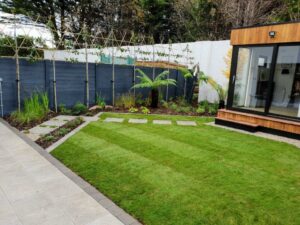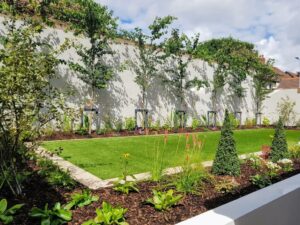Planting Screening Trees & Privacy in your garden
Many of our clients come to us hoping for more privacy in their gardens, especially in Suburban areas around Dublin. This can be for a variety of reasons: for some people they are finally addressing the overlooking neighbours window, a nearby road they would rather block out, or, more & more often it is a new-build developments in the area that have changed the feeling of the garden. These types of Garden Design projects require Solution Planting. This is where we can help.
We use privacy screening to strategically break a view or block out views entirely. By working with planting, rather than built wall or tall fences, you are bringing foliage and life to the space. Introducing an intention Architectural look to the garden rather than bare walls. This approach gives definition and structure to a space in a very distinctive way. LandArt are experts in sourcing and planting screening trees, such as pleached trees, espalier trees and large evergreen trees.
Planting screening trees is a big investment and to plant them correctly requires a great deal of knowledge, skill, and experience.
To break it down into bite size pieces lets look at:
– Espalier Trees
– Standard Trees
– Hedging



Espalier Trees
To begin with, I want to answer what Espalier Trees are & why are they so effective. The purpose of Espalier or pleached trees is to give a row of foliage at height, often known as ‘a floaing hedge’ it literally elevates the block of foliage as an almost solid form above eye-level giving an unrivalled sense of privacy in your garden to sit out, entertain or relax. The vast majority of our boundary walls and fences in the rear of our gardens are around 1.8 metres tall. This is rarely sufficient to provide adequate or comfortable privacy in your garden. We find that raising the height of the fence or wall can cause great concern to neighbours and can cause structural problems down the road.
Espalier trees give a very refined look and immediate privacy screen to a garden. Generally, they are on a 1.8m clear stem, known as a ‘standard’. Although we often source as ½ or ¾ standards depending on existing fence or wall in the garden. The canopy of these trees are specifically trained to be flat, almost 2Diensional structures, a timber or metal frame is used to train the tree with only a vertical plane, either square or rectangular, ranging in size from 80cm to 120 or 150cm.
As with all tree selections there is a vast choice of species. The most important consideration for screening trees is whether it is being used primarily for privacy or as an aesthetic choice. My advice would be to only use evergreens when it is a privacy issue, this will ensure that you have year-round cover without losing leaf in the Autumn & Winter. Good options would be Photinia, Holly & Elaeagnus. If the choice for espaliers is more aesthetic than function then the options open up to include deciduous options to provide seasonal interest, with rusty Autumn leaves & zesty spring leaf. My favourite by far are Beech trees for their coppery winter tones (especially in a more sheltered garden that the tree retains some of its crispy leaves) other great options are Hornbeams and even fruit producing options such as Malus (Apple) or Pyrus (Pear).
You can see examples throughout our Gallery on the website of how we have used each of these in different situations for different results. Every garden and very project has unique conditions and a different objective.
One other important thing to note on Espalier trees is that due to the trained shape of these trees they are very efficient in terms of footprint. Making them ideal for use in smaller garden compared to how a row of standard trees would grow into the space over time.



Standard Trees
Be it a singular feature tree or a row of trees in repetition long a boundary wall a garden just doesn’t feel complete without some structure and height.
Carefully selecting the appropriate tree is a key element of Garden Design, you want the chosen tree to be striking without dominating the space, it has to work with the proportion of the space and be used in a way that draws the eye across the composition of the garden as a whole.
Trees which are produced in nurseries for planting as mature specimens, giving an instant impression, tend to be know as ‘standard trees’. This does not mean they are basic or generic! Quite the opposite, they can be the most magnificent and unusual of varieties. The ‘Standard’ simply refers to their height. As with the Espalier Trees this refers to their stem, a clear stem of 1.8m. And so it goes that a ½ std will have a stem of 900mm. You would recognise the ½ std as a ‘Lollypop’ or a perhaps a short weeping Acer.
The maturity of trees is gauged by the ‘girth’ of the tree rather than any reference to height. And this is where the variance in price comes into play. A standard tree can range from €295 up to 3 or even 4 times this cost depending on the specified girth. A younger tree will be only 6-8cm girth, a good decent size tree which we would often choose will be 10-12 or 12-14cm, and beyond that you are starting to look at a very substantial age of tree. It goes without saying that the older the tree the more substantial and established it will look when planted.
Trees are also habitat for our native wildlife and being conscious of our choices to create these environments can have a big impact. By opting for indigenous trees such as Holly, Birch & Rowan provides a much appreciated food-source for birds and pollinators alike, supplying a reliable source of winter berry & spring flowers. By incorporating a proportion of native elements into the garden you can ensure a more biodiverse planting scheme while still including very special feature plants. Showstoppers like Japanese Maples, Mediterranean Olives & Tasmanian Tree Ferns give the flair to many gardens, their unique form and colouring add personality and contemporary style to many Garden Designs. It is interesting to see more and more options come into the market though, with Scots Pine & Yew becoming popular as Cloud Form trees, and the Strawberry Tree (The Killarney Tree) a great alternative to Bay Lollipop.
Other considerations for tree selection is of course their suitability to aspect and soil condition. It is extremely important to know the shade tolerance or soil drainage preference of your trees, for example a Willow or Birch is naturally adapted to such conditions while Beech will not tolerate wet feet. Our go to trees for shade or North facing gardens are Bay, Photinia and to a certain extent Holly. While the sun worshipers like Olive, Acacia, Laburnum & Magnolia need a prime spot with at least 6rs+ daylight. Horticultural guidance is advised to ensure well positioned plants that are suitable and likely to be happy & thrive in their new location.



Hedging
Last but not least we have hedging. It seems to be in the Irish psyche to have a neat hedge around the perimeter of our homes. I was recently in the U.S. & I am always struck by the difference of attitude in how we define our gardens. It could not be more different. Rather than have our lawn run into the neighbours we like clear definition of boundary lines and secure enclosures that child, dog or other can roam freely without concern. This can be by means of fence, wall or hedge. The latter create living boundaries to our gardens, providing foliage, texture & architectural interest all year round. Add to this that they are homes to wildlife and provide numerous environmental benefits (ecosystem services), and it’s really worth considering them when replacing fences and walls.
As with selecting the right tree species there are several things to consider for hedging choice. Suitability for any plant selection is determined by the aspect, soil condition and wind expose. Often hedges are used as a wind break and so you must select a hardy species to endure this task an still thrive in location. Aswel as sheltering hedges can offer cooling & temperature regulation, even carbon sequestration and phytoremediation of soil pollutants.
Once the environmental requirements are kept in mind there are the following criteria to consider:
– Screening: Evergreen or Deciduous
– Style: Contemporary or Traditional
– Maintenance: Independently or Professionally
– Budget: Cost Conscious Solution or Instant Impression
Lets first decide do you want/need deciduous or evergreen hedges? Screening hedges are almost always Evergreen, Photinia, Laurel, even Bamboo. Narrowing this down you can then consider the style, there is no comparison how contemporary a line of Bamboo will look compared to a more traditional hedge row of Privet or Griselinia. Next is to consider how frequently can you can/you want to maintain the hedge? Some species of hedging are quite demanding, either in their growth habit or in the style they are used. For example, a knee-height Box or Yew hedge can look fantastic in a formal space, but it does demand an immaculate & uniform trim to look at its best, sometimes with busy lives this is best avoided! Instead, by opting for taller boundary hedges only, something like a Hawthorn or Photinia hedge, they are more forgiving and allow for a bit more of a loose and natural look, not needing as frequent attention. Coniferous hedges have been popular in the past, species such as Thuja or Yew, but its important to note that once these have attained a certain growth they cannot be cut back much beyond this width, meaning they can become out of hand if not maintained year or year. Leilandii have the worst reputation of all, to the point that Leylandii is disliked & disapproved of by many County Councils. A reliable evergreen that can be cut back hard, surviving and looking well even with some neglect are Laurels. If Laurels are your preference, ever popular for their evergreen leaves, then bear in mind that the faster the variety grows the more instant a hedge you will have. This can be a real benefit with budgeting a garden. As you can opt for a much younger plant and still have a mature hedge within a few years. But do weigh up this decision carefully, Common Laurel has phenomenal growth, it can grow 40cm-60cm+ a year, meaning it needs more regular care than a slower growth habit Laurel such as Bay, Genolia or Portuguese at 20-30cm a year. Lots to consider for hedging. We can help you navigate all of the above, LandArt offer services on not just design & planting but also for onsite consultation.
All of these considerations need to be weighed up & often these are the decisions we make instinctively when meeting with clients. As Garden Designers we weigh up the needs & conditions of the space, be it established or a blank canvas. Taking into account the functional priorities and visual intention aswel as realistic maintenance, budget available and any personal preferences of our clients.
As I’ve mentioned hedges provide benefits for us and the wildlife that lives in our gardens. They have the natural ability to capture pollution, reduce noise, mitigate flooding and provide food and shelter to wildlife. They provide numerous other environmental and practical benefits. More and more we are recognising the social wellbeing benefits of our green spaces, they can reduce stress levels in humans through visually stimulating us & providing refuge in a busy world.
How could anyone not love a hedge ![]()
We would love to speak to you about creating your perfect outdoor space, so get in touch today


